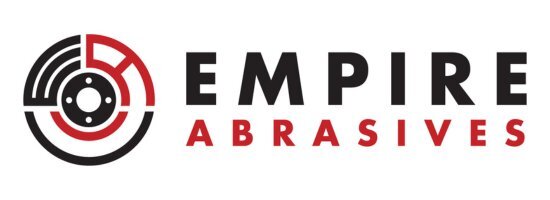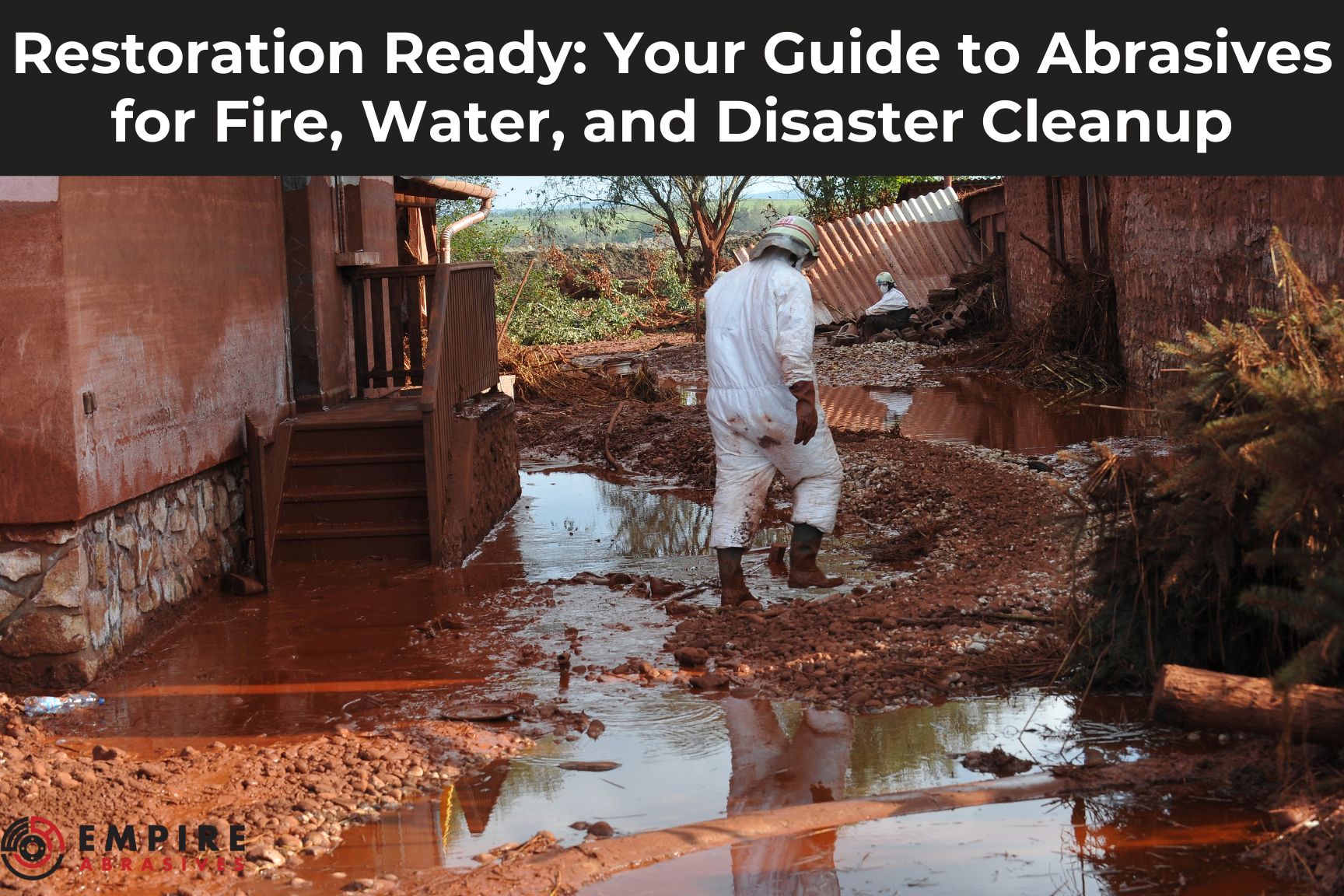
When disaster strikes, the path to recovery is often challenging, demanding speed, resilience, and the right equipment. For the dedicated restoration professionals, general contractors, municipal crews, and facility managers tackling the aftermath, efficiency and effectiveness are paramount. Amidst the chaos of cleanup, specialized tools become essential allies. While often overlooked, abrasives play a critical role in removing damage, cleaning surfaces, and preparing structures for repair and rebuilding.
This guide is for the teams on the front lines of recovery. Whether you're facing down the remnants of a fire, the widespread impact of a flood, the destructive force of a storm, or the persistent challenge of mold, understanding how to leverage the right abrasive tools can significantly impact your workflow, safety, and the quality of the final restoration. Let's explore the common disaster scenarios and the specific abrasive applications that help bring properties back from the brink.
Common Disaster Scenarios & Abrasive Applications
Each disaster leaves a unique footprint of damage, requiring specific approaches for cleanup and preparation. Here’s how abrasives fit into the workflow for common scenarios:
Flood / Major Water Damage
 Standing water or major leaks can saturate building materials, leading to swelling, warping, deterioration, peeling paint, stubborn mud deposits, metal corrosion, and creating conditions ripe for mold growth. Once materials are thoroughly dried and non-salvageable items are removed, abrasives step in for surface preparation.
Standing water or major leaks can saturate building materials, leading to swelling, warping, deterioration, peeling paint, stubborn mud deposits, metal corrosion, and creating conditions ripe for mold growth. Once materials are thoroughly dried and non-salvageable items are removed, abrasives step in for surface preparation.
Abrasive Applications:
- Sandpaper / Sanding Discs & Belts / Sanding Sponges: Smooth warped wood, remove water-damaged paint, and feather the edges of drywall patches
- Wire Wheels/Brushes (Manual or Power): Scrub away dried mud, silt, and light corrosion from concrete, masonry, and metal fixtures
- Scouring/Scuff Pads: Clean grime and residue from non-porous surfaces like tile, sinks, tubs, and metal fixtures
Fire & Smoke Damage
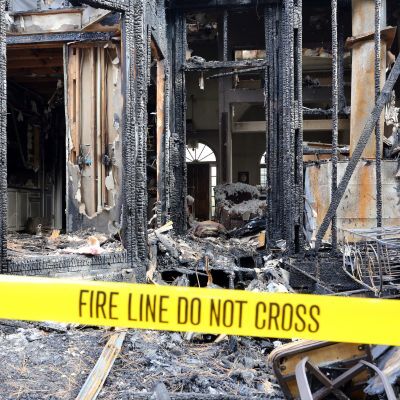 Fire damage restoration presents perhaps the most complex abrasive challenges, with charred materials, pervasive soot, and smoke damage requiring various approaches depending on the surface and degree of damage.
Fire damage restoration presents perhaps the most complex abrasive challenges, with charred materials, pervasive soot, and smoke damage requiring various approaches depending on the surface and degree of damage.
Common Damage:
- Charred wood and other materials
- Heavy soot coating virtually all surfaces
- Smoke staining that can penetrate porous materials
- Heat-damaged paints and finishes
- Melted materials
Abrasive Applications:
- Metal Wire Brushes (Manual & Power): Aggressively remove layers of char from structural wood and scrub heavy soot from brick, stone, or concrete surfaces.
- Nylon Abrasive Wheels: Degrease and de-gloss smoke-stained brick or stone without damaging masonry. Ideal for historic buildings where gentler cleaning is required
- Sandpaper / Sanding Discs / Sanding Belts: Smooth wood surfaces post-char removal and eliminate residual smoke stains, preparing them for sealers and primers.
- Scouring/Scuff Pads: Clean soot and smoke residue from metal items and hardware without causing excessive surface damage.
Storm / Wind Damage (Hurricanes, Tornadoes, Severe Storms)
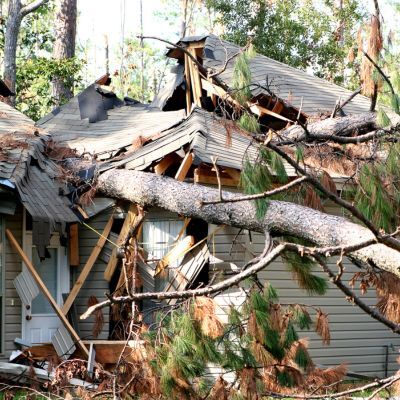 High winds and impacts from debris can cause significant structural damage, leaving behind splintered lumber, damaged roofing and siding, embedded debris, scratches, and exposed metal fasteners prone to rusting. Abrasives are vital for both demolition and preparation for repair.
High winds and impacts from debris can cause significant structural damage, leaving behind splintered lumber, damaged roofing and siding, embedded debris, scratches, and exposed metal fasteners prone to rusting. Abrasives are vital for both demolition and preparation for repair.
Abrasive Applications:
- Cutting Wheels (Angle Grinder): Quickly cutting through damaged metal roofing, siding, gutters, flashing, or straps for safe removal. Severing protruding damaged bolts, rebar, metal fence posts, or other hazardous metal debris.
- Grinding Wheels / Flap Discs (Angle Grinder): Smooth sharp edges on broken metal, grinding down damaged welds, remove rust, and prepare damaged metal components for repair. Occasionally used to grind down damaged or uneven concrete edges. Flap discs are particularly effective for rapid rust and paint removal on metal.
- Sandpaper / Sanding Discs / Belts: Smooth splintered wood edges on framing, decks, or fences, and prepare surfaces for patching and sealing.
- Wire Brushes: Clean dirt, embedded debris, and rust from surfaces to ensure a stable base for restoration.
Mold Remediation (Post-Treatment Surface Preparation)
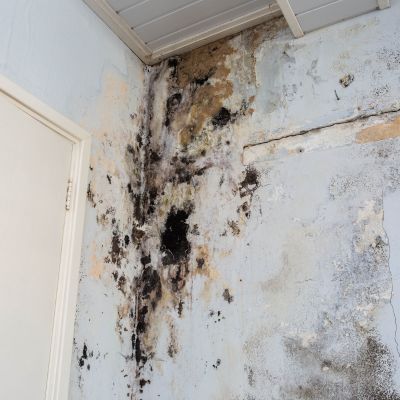 Often following water damage, mold growth requires careful handling according to industry protocols. Abrasives do not kill mold. Their role comes after the affected area has been contained, porous materials removed (like contaminated drywall), and remaining structural elements (like wood framing) have been thoroughly cleaned, disinfected, and dried by trained professionals.
Often following water damage, mold growth requires careful handling according to industry protocols. Abrasives do not kill mold. Their role comes after the affected area has been contained, porous materials removed (like contaminated drywall), and remaining structural elements (like wood framing) have been thoroughly cleaned, disinfected, and dried by trained professionals.
Abrasive Applications:
- Sandpaper / Sanding Discs / Sanding Sponges: Used within containment and often with HEPA vacuum extraction, these tools physically remove residual mold staining and potentially embedded, non-viable mold hyphae from wood surfaces (studs, sheathing) after disinfection.
- Wire Brushes: While sometimes used cautiously on robust surfaces like concrete after disinfection to remove heavy staining, they are generally less preferred for wood in mold remediation due to the risk of damaging the wood surface and potentially aerosolizing any missed spores if not used with proper HEPA control.
Essential Abrasive Types for Cleanup Kits
Having a well-stocked kit with a variety of abrasive types ensures your crew can efficiently tackle the diverse challenges encountered on a restoration site. Here are the core abrasives frequently relied upon:
- Sandpaper & Sanding Discs: Used for smoothing rough wood surfaces after damaged sections are removed. They help prepare surfaces by feathering edges, removing blistered or smoke-damaged paint, and even light rust on metal. For mold remediation, finer grits can physically remove residual staining and spores from porous materials.
- Cutting Wheels: Essential for metal cutting tasks, these tools remove damaged pipes, cut rebar, sheared bolts, or compromised metal studs. They also serve as a demolition aid—enabling quick access or removal of damaged metal panels and structures.
- Grinding Wheels/Discs and Flap Discs: These tools handle heavy material removal on metal and masonry. Grinding wheels smooth rough edges and prepare welds, while flap discs aggressively strip paint, rust, and coatings, making surfaces ready for repair or recoating.
- Wire Wheels/Brushes (Manual & Power Tool Attachments): The go-to tool for aggressively removing heavy rust, corrosion, caked-on debris (mud, concrete spatter), and especially critical for scraping away charred wood layers and heavy soot after fires. Essential for cleaning heavily contaminated or textured surfaces where other abrasives might fail or load quickly.
- Sanding Belts: These excel at rapid, aggressive material removal on large, flat surfaces. Ideal for sanding down water-damaged subflooring, leveling charred beams or joists, stripping paint from large wood surfaces, and quickly shaping repairs.
- Scouring Pads (Non-woven Scuff Pads): Used for general cleaning of grime, soot, or residues from semi-smooth surfaces where heavy abrasion isn't needed (countertops, fixtures, tile). Also useful for fine finishing/polishing on metal or between finish coats on wood.
Choosing the Right Abrasive for the Job (and Material)
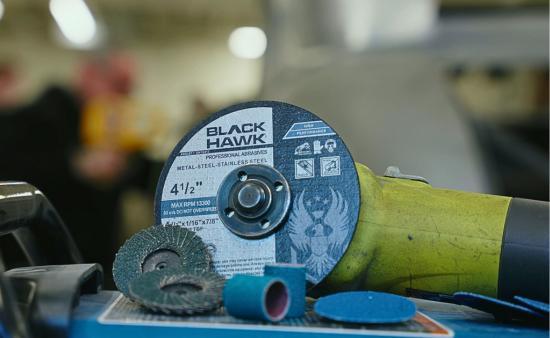
Selecting the correct abrasive is crucial for working efficiently, achieving the desired result, and ensuring safety. Using the wrong type or grit can waste time, damage the material, or even create hazards. Consider these key factors:
- Material Being Worked On:
- Wood: Aluminum Oxide is a common, effective abrasive. For more aggressive removal or dense woods, Zirconia or Ceramic Alumina can offer longer life and faster cutting.
- Metal: For ferrous metals (steel, iron), Zirconia and Ceramic Alumina provide durability and fast cutting, especially for grinding and heavy stock removal. Aluminum Oxide works well for general purpose sanding and finishing. For non-ferrous metals (aluminum, brass), specific abrasives designed not to "load" (clog) quickly are preferable.
- Paint/Coatings: Coarser grits (40-80) are typically needed for stripping. The abrasive material choice often depends on the underlying substrate.
- Concrete/Masonry: Silicon Carbide or diamond abrasives are generally required for effective grinding or cutting, though wire brushes work well for surface cleaning.
- Task & Severity of Damage:
- Heavy Removal: Removing significant char, rust, thick paint, grinding welds, or leveling uneven surfaces requires aggressive, coarse-grit abrasives (typically 24 - 60 grit) often made from Ceramic or Zirconia, used with tools like grinders or belt sanders.
- Surface Preparation & Smoothing: Removing lighter damage, smoothing surfaces after rough work, or preparing for paint/sealant typically uses medium grits (80 - 120 grit).
- Finishing: Achieving a very smooth surface before final painting or sealing requires finer grits (150 grit and higher).
- Abrasive Grain Material:
- Aluminum Oxide (AO): Good all-around abrasive for wood, metal finishing, paint prep. Friable (breaks down to expose new sharp edges), but less durable than others under high heat/pressure.
- Zirconia Alumina (Zirc): Tougher than AO, great for heavier grinding on metals and aggressive wood sanding. Requires more pressure to fracture and expose new edges.
- Ceramic Alumina: Hardest and most durable grain, excellent for aggressive metal grinding and dimensioning hardwoods. Fractures precisely under high pressure for consistent, fast cutting, but often comes at a higher price point. Best value is seen in high-pressure, demanding applications.
- Silicon Carbide: Very sharp grain, often used for masonry, glass, plastic, and sometimes non-ferrous metals or final finishing passes on wood.
- Grit Size: Remember the basic rule: Lower grit number = Coarser abrasive (more material removal, rougher finish). Higher grit number = Finer abrasive (less material removal, smoother finish). Starting too fine wastes time; starting too coarse can cause deep scratches that are hard to remove later. Often, you'll work through a progression of grits.
Why Partner with Empire Abrasives for Disaster Response Needs?
When facing the demanding pace and challenging conditions of disaster restoration, you need suppliers who understand your requirements and deliver reliably. Empire Abrasives is committed to supporting restoration professionals with the tools they need, exactly when they need them. Here’s why leading restoration companies choose us:
- Product Performance & Reliability: Our abrasives are selected for durability and performance, built to withstand the tough materials and demanding usage common on restoration sites, minimizing downtime and maximizing productivity.
- Wide Selection Under One Roof: From heavy-duty cutting wheels and grinding discs to specialized sanding belts and finishing products, we offer a comprehensive range, simplifying your procurement process. Find the right tool for virtually any abrasive task involved in cleanup and surface prep.
- Bulk Availability & Business Solutions: We understand restoration work often requires large quantities of consumables. Our large inventory and B2B focus mean we are equipped to handle volume orders, offering competitive pricing structures designed for business accounts.
- Expert Support When You Need It: Not sure which grit or abrasive type is best for a specific application? Our team of abrasives experts is ready to provide guidance and help you select the most effective products for your job.
- Logistics You Can Count On: In disaster response, waiting for supplies isn't an option. Our warehouse is fully stocked, ensuring product availability. We pride ourselves on fast order processing, with most orders shipping within one business day, and offer upgraded shipping options to meet urgent needs.
Equipping Your Restoration Efforts
The road to recovery after a disaster is built on hard work, expertise, and the right tools for the job. Quality abrasives are fundamental to efficiently removing damage, thoroughly cleaning surfaces, and properly preparing structures for repair – critical steps that ensure the longevity and safety of the restoration. Choosing the appropriate cutting wheel, grinding disc, sanding belt, or finishing abrasive not only speeds up the process but also contributes significantly to the overall quality of the outcome.
Empire Abrasives stands ready to be your trusted partner, providing the durable, high-performance abrasive solutions your crews need to tackle the toughest cleanup and restoration challenges. Equip your team with the tools they need to restore properties safely and effectively.
Ready to equip your restoration team with professional-grade abrasives? Browse our online catalog of premium abrasives at EmpireAbrasives.com or contact our team directly at 1-800-816-3824 to discuss custom solutions for your specific restoration challenges.

